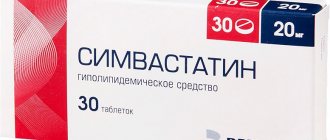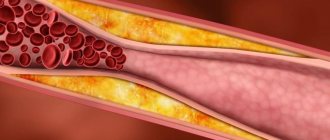Pharmacodynamics and pharmacokinetics
Pharmacodynamics
The drug is an inactive lactone and belongs to the synthetic derivatives of Aspergillus terreus . During metabolism, a hydroxy acid derivative is formed, which inhibits HMG-CoA reductase , which catalyzes the reaction that initiates the formation of mevalonate , which is involved in the initial stage of cholesterol . At the same time, taking the drug is not accompanied by the accumulation of sterols . Under the influence of simvastatin, lipoproteins , triglycerides and total cholesterol in the body decreases . At the same time, the level lipoproteins . The effect in most patients appears within 10-14 days from the start of administration and reaches its peak after 1-1.5 months. After stopping taking the drug, cholesterol return to their previous levels slowly.
Pharmacokinetics
Simvastatin is well absorbed; the maximum concentration in the blood is observed on average after two hours. High binding to blood proteins - about 95%. It is transformed in the liver with the formation of beta-hydroxy acid , which has high pharmacological activity. The half-life of metabolites is about two hours. It is excreted in the form of metabolites through the intestines and, to a lesser extent, through the kidneys.
Compound
| Film-coated tablets | 1 table |
| active substance: | |
| simvastatin (with butylated hydroxyanisole 0.01%) | 10 mg |
| 20 mg | |
| 40 mg | |
| excipients: lactose monohydrate - 70.73/141.46/282.92 mg; butylated hydroxyanisole - 0.02/0.04/0.08 mg; ascorbic acid - 2.5/5/10 mg; citric acid monohydrate - 1.25/2.5/5 mg; MCC RN101 - 5/10/20 mg; pregelatinized starch - 10/20/40 mg; magnesium stearate - 0.5/1/2 mg | |
| film shell: Opadry II 33G24737/39G22514/33G26729 (hypromellose - 40/40/40%, titanium dioxide - 20.5/22.85/22.6%, lactose monohydrate - 22/21/21%, macrogol - 8/ 8/8%, glycerol triacetate (triacetin) - 6/6/6%, yellow iron oxide dye - 0/2.13/0.47%, red iron oxide dye - 3.4/0.01/1.52 %, black iron oxide dye - 0.04/0.01/0.41%, aluminum varnish based on indigo carmine dye - 0.06/0/0%) - -/-/12 mg |
Indications for use
- Hypercholesterolemia : Types IIa and IIb of primary hypercholesterolemia in the absence of the effect of a low-cholesterol diet and non-drug measures (weight loss, physical activity) in patients at risk of developing atherosclerosis of the heart vessels; combined hypertriglyceridemia and hypercholesterolemia ;
- Coronary heart disease : to reduce the risk of death after myocardial infarction , to reduce the risk of developing disorders of the cardiovascular system ( stroke ), to slow down the development of atherosclerosis of the coronary vessels.
special instructions
According to the instructions, Simvastol should not be prescribed to patients with an increased risk of developing rhabdomyolysis and renal failure. Risk factors for these pathologies include an acute form of severe infection, arterial hypotension, planned major surgery, trauma, and severe metabolic disorders.
The use of the drug is not indicated for hypertriglyceridemia types I, IV and V.
Treatment with Simvastol should be accompanied by monitoring of liver function. Studies of liver enzyme activity are carried out before starting to use the drug and regularly during therapy: 2 times every 6 weeks, then every 8 weeks until the end of the first year, then once every six months. A liver function test should be performed at each dose increase, and at a daily dose of 80 mg, every 12 weeks. A transient increase in liver enzyme levels is possible at the beginning of therapy. If transaminase activity exceeds 3 times the initial level and maintains a steady increase, the pills should be discontinued.
For patients with hypothyroidism and/or kidney disease (including nephrotic syndrome) with elevated cholesterol levels, it is recommended that the underlying disease be treated first.
In addition to monotherapy, the use of the drug is indicated in combination with bile acid sequestrants.
It is recommended to avoid simultaneous consumption of large quantities (more than 250 ml) of grapefruit juice, since the severity of side effects of simvastatin may be increased.
With the use of Simvastol, the development of myopathy, rhabdomyolysis and renal failure is possible. Symptoms of these pathologies include the appearance of muscle soreness, unexplained pain, lethargy or muscle weakness, accompanied by general malaise or fever. The risk of developing myopathy increases with simultaneous use of fibrates (fenofibrate, gemfibrozil), nefazodone, cyclosporine, macrolides (clarithromycin, erythromycin), HIV protease inhibitors (ritonavir), and azole antifungals (itraconazole, ketoconazole). In addition, the likelihood of developing myopathy is higher in patients with severe renal failure. When prescribing the drug, the doctor must warn the patient about the possibility of this disease, its symptoms and the need to immediately contact a specialist if they develop.
In patients with suspected or diagnosed myopathy, Simvastol should be discontinued.
Patients of childbearing age should use reliable contraception during the entire period of taking the drug. If pregnancy occurs during treatment, the drug should be stopped, and the woman should be warned about the possible risk to the fetus.
Cancellation of lipid-lowering drugs during pregnancy does not significantly affect the result of long-term therapy for primary hypercholesterolemia.
If myalgia, myasthenia gravis and/or a marked increase in CPK activity occurs, the use of Simvastol should be discontinued.
If you accidentally miss the next dose, it should be taken as soon as you remember, provided that this does not mean taking two doses at the same time.
In case of severe renal failure, treatment should be carried out by monitoring renal function.
The patient must follow a cholesterol-lowering diet before starting therapy and during the entire period of taking Simvastol.
The effect of the drug on the patient’s ability to drive vehicles and machinery has not been established.
Side effects
Nausea, vomiting, abdominal pain, flatulence , diarrhea , constipation, pancreatitis , hepatitis , dizziness , headache muscle cramps asthenic syndrome , insomnia , paresthesia , neuropathy , taste disturbance, myalgia , weakness, muscle cramps, photosensitivity , eosinophilia , increased ESR , thrombocytopenia , allergic reactions, anemia , decreased potency, skin hyperemia, palpitations.
Simvastol, instructions for use (Method and dosage)
Treatment with the drug should be carried out against the background of prescribing a hypocholesterol diet . Take Simvastol tablets once a day, without food intake, preferably in the evening, with water.
Treatment of hypercholesterolemia - the initial dose is 10 mg and further dose adjustment should be carried out every 4 weeks. the optimal effect is observed in patients when prescribing a dose of up to 20 mg/day. The maximum dose of the drug per day should not exceed 80 mg.
For the treatment of patients with coronary artery disease , the effective dose of the drug is 20-40 mg/day. Dose adjustment is carried out monthly; according to indications, the dose can be increased to 40 mg per day. Elderly patients and patients with moderate renal failure
Overdose
Cases of Simvastol overdose known to specialists (the maximum dose taken was 450 mg) were not accompanied by the manifestation of specific symptoms. Gastric lavage and activated charcoal are recommended as treatment. Symptomatic therapy is also prescribed and the level of CPK in the blood serum and kidney and liver function are constantly monitored.
If the patient develops myopathy with rhabdomyolysis and acute renal failure (a severe but rare side effect), it is necessary to discontinue the drug and administer sodium bicarbonate and a diuretic to the patient via intravenous infusion. If necessary, hemodialysis is performed.
Rhabdomyolysis can provoke hyperkalemia, which is eliminated by the use of potassium ion exchangers, intravenous administration of calcium gluconate or calcium chloride, glucose infusion with the addition of insulin, or in particularly severe cases through hemodialysis.
Interaction
Co-administration of simvastatin with cytostatics, nicotinic acid , antifungal drugs, HIV protease inhibitors, immunosuppressants, clarithromycin , telithromycin , erythromycin , amiodarone , verapamil and diltiazem increases the risk of developing myopathy. Simvastatin enhances the effect of anticoagulants, thereby increasing the risk of bleeding. Colestipol and cholestyramine reduce the bioavailability of simvastatin . Grapefruit juice consumed in quantities of more than 1 liter per day increases the inhibitory activity of HMG-CoA reductase in the blood.
Contraindications
- myopathy;
- active phase of liver disease, sustained increase in the activity of liver enzymes of unknown etiology;
- hereditary lactose intolerance;
- history of hypersensitivity to other HMG-CoA reductase inhibitors (statin drugs);
- period of pregnancy and breastfeeding;
- children and adolescents up to 18 years of age;
- individual intolerance to the components of the drug.
It is recommended to prescribe Simvastol with caution for: chronic alcoholism; simultaneous therapy with immunosuppressants after organ transplantation (increased risk of renal failure and rhabdomyolysis); a history of liver disease; decreased or increased skeletal muscle tone, unknown etiology; epilepsy; conditions that contribute to the development of severe renal dysfunction, such as arterial hypotension, severe acute infectious diseases, severe metabolic and endocrine disorders, water and electrolyte imbalance, trauma and surgical interventions (including dental surgeries).
Analogues of Simvastol
Level 4 ATX code matches:
Akorta
Atomax
Lipitor
Pravastatin
Owencore
Simgal
Tulip
Lovastatin
Liptonorm
Rozulip
Zokor
Rosart
Tevastor
Atorvastatin
Liprimar
Simvastatin
Atoris
Basilip
Rosecard
Roxera
Drugs with similar therapeutic effects include: Atherostat , Vasilip , Avestatin , Vero-Simvastatin , Actalipid, Zocor forte , Zovatin , Levomir , Ovencor , Zocor , Simvahexal , Zorstat , Simvacor , Simvastatin , Simvacard , Simlo , Sincard , Simvor , Simplacor , Simgal , Kholvasim and others.

